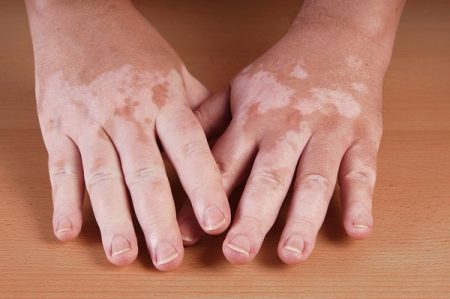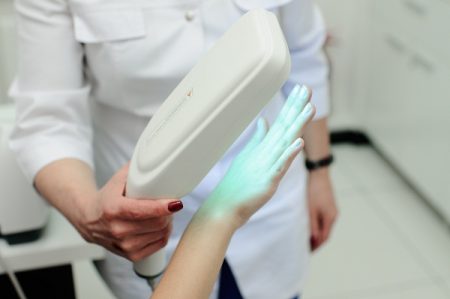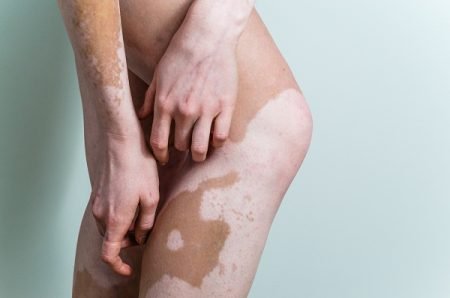Penile Vitiligo (Vitiligo on the Penis): Symptoms, Treatment and More
- Updated on: Jul 5, 2024
- 5 min Read
- Published on Apr 22, 2021

What Is Vitiligo?
Vitiligo is a long-term skin condition in which the skin loses its pigment cells (melanocytes). This can result in discoloration of skin in the form of discolored patches in different parts of the body, such as the skin, hair, retina and mucous membranes.
The patches of skin affected by vitiligo become white and often have sharp margins. The hair from the skin may also become white. Sometimes, there may be discoloration of the inside of the mouth and nose. The condition may be more noticeable in people with darker skin. Vitiligo treatment can improve the appearance of the skin but it doesn’t cure the disease completely. Vitiligo has no cure till date.
Read more about:
Symptoms and Complications of Vitiligo
Penile Vitiligo (Vitiligo of Penis)
Vitiligo can affect skin in any part of the body such as hands, arms, face, genital areas including the penis in men and labia in women. If it affects the penis, it is called penile vitiligo.
Signs and Symptoms of Vitiligo on Penis: What Does Penile Vitiligo Look Like?
Most common signs and symptoms of penile vitiligo (also called vitiligo on penis) are:
- Penis skin discoloration
- Colors of penises of people (particularly penile shafts or foreskin) are different than the color of the rest of their bodies
- Patches of skin on and around the penis lose pigmentation and turn white or lighter than the surrounding skin. People notice white spots on penis shaft or foreskin or white dots on penis as a result of discoloration of the skin.
Vitiligo affects different individuals differently. Some people may have many body parts affected with discoloration; others may have only one body part or one side of the body affected. Sometimes, the condition progresses fast; in other cases it grows slowly and may go on for several years. Not everyone gets vitiligo-specific white patches on the penis or vulva.
It’s not common for pigmentation to return. Once the discoloration has happened, it does not improve on its own.
Causes of Vitiligo
Vitiligo occurs when the cells in your body that produce skin color (melanocytes) either stop working properly or die. It can cause discoloration of many parts of the body including your penis. Some people also experience discoloration on their hair and eyeballs, and not just the skin. The causes of vitiligo are not well understood, but it is believed that the following factors play potential role in the occurrence of vitiligo symptoms:
- Genes (heredity)
- Stress
- Sunburn
- Exposure to certain chemicals
- Immune system dysfunction
Types of Penile Vitiligo
Penile vitiligo or vitiligo of penis has been categorized into three types depending upon the areas to which it has spread:
Localized Vitiligo: It is a type of penile vitiligo which is confined to just one or two areas of the penis and does not spread.
Generalized Vitiligo: This type of vitiligo is found all over the body, including the penis.
Segmental Vitiligo: This type of vitiligo is found on just one side of the body.
How Is Penile Vitiligo Diagnosed?
Vitiligo of the penis is diagnosed in a physical examination. The disease causes the occurrence of white spots on penis or white dots on penis shaft, which is a characteristic sign of vitiligo. The appearance of penile vitiligo spots or penile discoloration generally helps the doctor understand the symptoms and diagnose the disease.
Vitiligo of the penis usually appears as penile discoloration on the foreskin, and sometimes though less commonly penile discoloration on the glans (head) of the penis.
Is Penile Vitiligo Contagious?
It is imperative to understand that vitiligo does not fall under the category of sexually transmitted infections (STIs). The condition is non-transmissible through dermal contact and its etiology is predominantly attributed to autoimmune processes rather than bacterial or viral pathogens. Furthermore, vitiligo localized to the genital region does not compromise penile functionality.
Treatment of Vitiligo on the Penis and Foreskin
Vitiligo is treated with medications, topical creams, laser therapies, and surgical methods. However, vitiligo symptoms can recur after treatment and new spots or patches can appear in the same or a different location. In some patients, circumcision or excision of the affected areas of the penile skin can be an effective treatment method. Surgical excision along with circumcision is considered an effective treatment option for vitiligo of the penis that does not respond to oral or topical treatments such as medication or creams.
A simple remedy that you can apply at home for vitiligo is the use of a topical self-tanner or makeup to hide the lightened skin. But the skin of penis is too sensitive for this treatment option, and therefore should not be tried in case of penile vitiligo. It can interfere with your sexual activities and sexual pleasure.
Corticosteroid creams can reduce the extent of lightening of the skin, but they can make the skin thinner with regular use and cause other problems of the skin of penis.
Light (such as ultraviolet light) therapy can be effective in treating some patients. But for penis, this may not be recommended by doctors in most cases. Light therapy can cause dryness and itchiness on skin of the penis that is too delicate for such treatments.
Is Vitiligo of the Penis Dangerous? Can it Cause Complications?
Vitiligo of the penis is not a dangerous condition. But, it is related to aesthetics and the appearance of the penis is often the biggest concern of patients. Penile vitiligo does not affect the function of the penis at all. The ability to get erections and sexual pleasure or sensitivity are not affected by vitiligo in most cases.
People who have vitiligo may be at higher risk for sunburn, skin cancer, hearing loss and eye problems. You should protect the skin from the sun if you have vitiligo.
Psychological and social problems: Social and psychological distress may occur as a result of white spots or white dots on penis. People often feel self-conscious about these effects of the condition on penis or vulva (in case of women).
Does Vitiligo on Penis Affect a Man’s Sex Life?
While the condition in itself does not affect sexual pleasure or sexual sensitivity, however, the anxiety of a person about exposing his penis to a partner may affect the sexual pleasure of sexual activity.
There is certainly no reason for men to feel ashamed or embarrassed about the white patches or spots on the penis due to vitiligo. It is better to openly speak to your partner about it. If your partner has any concerns, you both can meet a counselor or a doctor who can help her understand and provide reliable information. Knowledge about the condition can help a couple cope with it better.
Cosmetic camouflage is considered a viable solution for individuals who want to minimize the appearance of vitiligo symptoms, particularly in sensitive areas such as the genitals pr penis. Medical tattooing, also known as micropigmentation, and the use of dermatologically tested dyes can also effectively even out variations in skin tone and reducing the perception of penile vitiligo, thus reducing the contrast between affected and unaffected areas. It is important, however, to entrust these delicate procedures to certified dermatologists or cosmetic professionals who are specialized in medical tattooing for vitiligo. These experts can ensure that pigments match your skin tone as closely as possible and that the procedures are performed under strict hygienic conditions to prevent any complications resulting out of such tasks. By choosing the right care professional, you can achieve a more uniform skin appearance, which may significantly improve your psychological well-being and self-confidence. Talk to your doctor if you are concerned or want to know more about these procedures.
FAQs
Is Vitiligo a Sexually Transmitted Disease?
No, vitiligo is not a sexually transmitted disease and can’t spread to your sexual partner. It is non-contagious and cannot spread through sexual intercourse or sharing personal items.
What Is the Fastest Way to Cure Vitiligo?
There is no cure for vitiligo, however, some home remedies may help in getting some positive results. Applying turmeric and mustard oil may stimulate the pigmentation and therefore help in somehow improving the symptoms.
Where Does Vitiligo Usually Start?
The development of vitiligo generally starts on the face, forearms, hands, and feet and then gradually starts spreading to any part of the body including mucous membranes, nose, inner ears, eyes, etc.
Can Vitiligo Spread Overnight?
In some cases the vitiligo remains confined to a specific site and does not spread to other body parts. However, it may spread over many years or may spread rapidly in some people.













1 Comment
Hello. impressive job. I did not imagine this. This is a impressive story. Thanks!